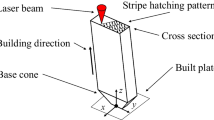Abstract
The current text presents a parametric study of two active thermography routines namely, Pulse and Lock-in as applied to carbon fiber reinforced plastics (CFRP) composites; using a Taguchi design of experiment approach. A set of controllable factors are highlighted and selected for each technique at different levels. Three factors have been identified for the pulse thermography (specifically; defect aspect ratio, pulse period, and experimental duration), and two factors for the Lock-in mode (that is lock in frequency and period); each factor can be manipulated at three different levels. The analysis reveals the effectiveness of the Taguchi design of experiment in consolidating the number of factorial experiments, and in quantifying the results and the associated sensitivity for each factor (its dominance), using a signal to noise ratio criterion. The analysis of variance and analysis of means show that the aspect ratio is not a controlling parameter for the pulse thermography, with the pulse time being the most dominant. Moreover, it decides on the optimal settings for each testing mode. These settings are further validated using additional CFRP artificial sample with eight and six layers of laminates.












Similar content being viewed by others
References
Maldague, X.P., Moore, P.: Nondestructive Testing Handbook: Infrared and Thermal Testing, vol. 3. American Society for Nondestructive Testing, Columbus (2001)
Omar, M., et al.: Infrared seed inspection system (IRSIS) on painted car shells. Infrared Phys. Technol. 48(3), 240–248 (2006)
Wiggenhauser, H.: Active IR-applications in civil engineering. Infrared Phys. Technol. 43(3), 233–238 (2002)
Maldague, X.: Theory and Practice of Infrared Technology for Nondestructive Testing. Wiley, New York (2001)
Edis, E., Flores-Colen, I., De Brito, J.: Building thermography: detection of delamination of adhered ceramic claddings using the passive approach. J. Nondestruct. Eval. 34, 26 (2015)
Sakagami, T., et al.: Development of self-reference lock-in thermography and its application to remote nondestructive inspection of fatigue cracks in steel bridges. Quant. Infrared Thermogr. J. 7(1), 73–84 (2010)
Wu, D., Busse, G.: Lock-in thermography for nondestructive evaluation of materials. Rev. Gen. Therm. 37(8), 693–703 (1998)
Chang, J., Zheng, C., Ni, Q.-Q.: The ultrasonic wave propagation in composite material and its characteristic evaluation. Compos. Struct. 75(1), 451–456 (2006)
Hiasa, S., Birgul, R., Catbas, N.: Effect of defect size on subsurface defect detectability and defect depth estimation for concrete structures by infrared thermography. J. Nondestruct. Eval. 36, 57 (2017)
Fisher, R.A., Wishart, J.: The Arrangement of Field Experiments and the Statistical Reduction of the Results. Imperial Bureau of Soil Science, Harpenden (1930)
Fisher, R.A.: The Design of Experiments. A Classical Textbook on Experimental Design. Oliver and Boyd, Edinburgh (1947)
Wu, C.J., Hamada, M.S.: Experiments: Planning, Analysis, and Optimization, vol. 552. Wiley, Hoboken (2011)
Roy, R.K.: Design of Experiments Using the Taguchi Approach: 16 Steps to Product and Process Improvement. Wiley, New York (2001)
Kilickap, E.: Optimization of cutting parameters on delamination based on Taguchi method during drilling of GFRP composite. Expert Syst. Appl. 37(8), 6116–6122 (2010)
Davidson, M.J., Balasubramanian, K., Tagore, G.: Experimental investigation on flow-forming of AA6061 alloy—a Taguchi approach. J. Mater. Process. Technol. 200(1), 283–287 (2008)
Chen, W.-C., et al.: A systematic optimization approach for assembly sequence planning using Taguchi method, DOE, and BPNN. Expert Syst. Appl. 37(1), 716–726 (2010)
Omar, M.A., Zhou, Y.: A quantitative review of three flash thermography processing routines. Infrared Phys. Technol. 51(4), 300–306 (2008)
Cho, Y.-J.: A study on the optimized test condition of lock-in IR thermography by image processing. J. Korean Soc. Nondestruct. Test. 32(3), 276–283 (2012)
Author information
Authors and Affiliations
Corresponding author
Rights and permissions
About this article
Cite this article
Abdulrahman, Y.A., Omar, M.A., Said, Z. et al. A Taguchi Design of Experiment Approach to Pulse and Lock in Thermography, Applied to CFRP Composites. J Nondestruct Eval 36, 72 (2017). https://doi.org/10.1007/s10921-017-0450-4
Received:
Accepted:
Published:
DOI: https://doi.org/10.1007/s10921-017-0450-4




